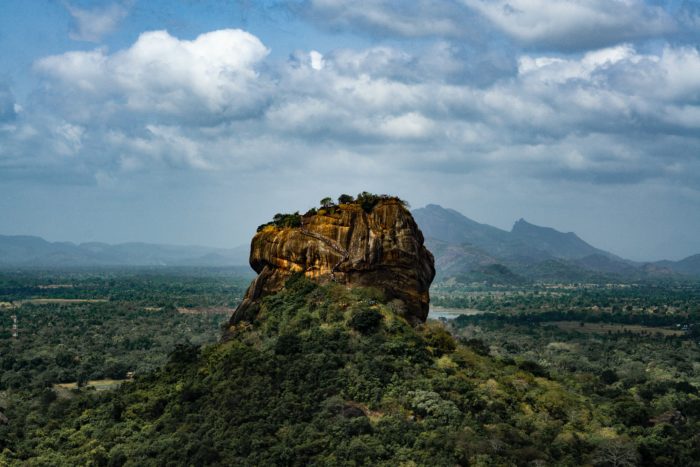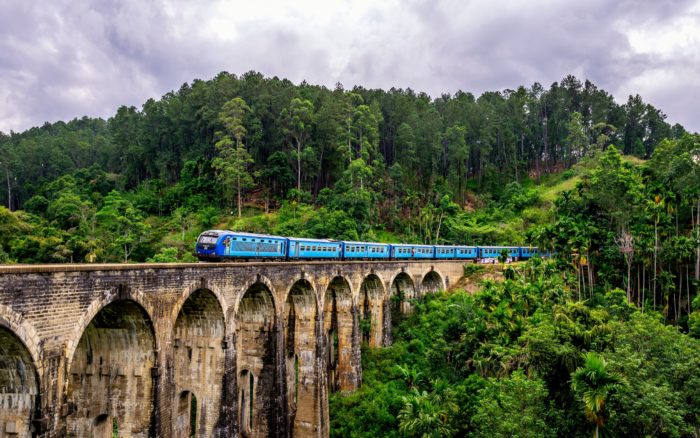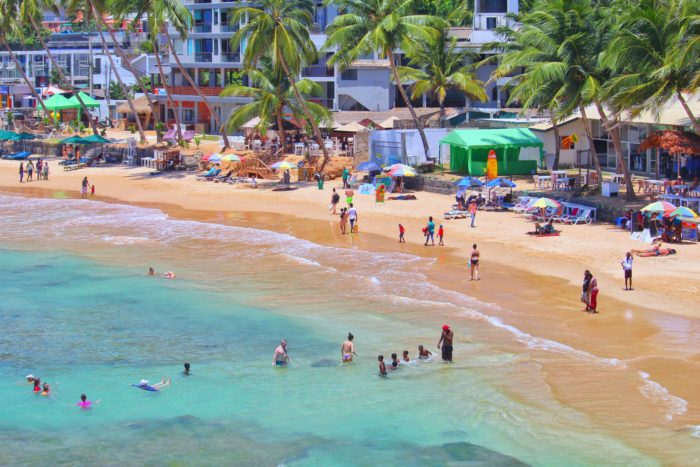COVID-19, Immobility and the Story of Sri Lanka’s Travel Industry

Image 1: Sigiriya Rock Fortress: the lure of heritage in Sri Lanka (Image credit Sander Don, Unsplash)
After presenting the most significant challenges faced by the Sri Lankan tourist industry since decolonisation, Dr Kamalika Jayathilaka reflects on what it means to put the sector under complete lockdown due to the COVID-19 pandemic.
Almost a decade back, I journeyed the many nooks and crannies of my island home fulfilling somewhat ecstatically the role of a travel writer. The war had just come to an end, and the country was gradually dusting off its acrid aftertaste, radiating once again the warmth of its well-known hospitality to the world. Raising its standards as a sought-after tourist destination it had begun to summon hordes of visitors bringing backpackers, surfers, beachgoers, birdwatchers, pilgrims as well as the nature and heritage enthusiast to the island. I enjoyed the new-found mobility and freedom thoroughly, being part of this revival; of seeing, experiencing and living fragments of a country, I had never yet set eyes upon. Through writing, I weaved countless stories told and untold about a country generated through my travels and experiences. In May 2020 - as the entire world lies frozen in an eerie stillness amidst the cruel grip of death and disease, I relate to this past-profession to recount once again a new story of this speck of an island in the Indian Ocean. This time, I do not write of its remarkable people places, history or culture but the plight of its travel industry at the face of a menacing global pandemic. But first, let me set this story in its backdrop.
Sri Lanka: A Tourism Journey Amidst Stifling Challenges
My country, a tourism hot-spot off the tip of the Indian subcontinent, has often been referred to as the pearl of the Indian ocean. Its location amongst regional powers and notable trade and maritime routes has led to a series of geopolitical effects mainly European colonisation since the 16th century. Harnessing the ensuing attention, particularly from the West, within its 50 or so years of organised tourism Sri Lanka has been promoted to the world as a Paradise Island. However, the story of its travel industry has often been considered one of untapped potential and missed opportunities amidst continuous challenges. Among these are three decades of civil conflict and the Indian Ocean Tsunami; the latter alone causing a tourism asset loss approximating US$ 250 million from damage to infrastructure (Buultjens et al., 2015) and drop in tourist numbers.
With the end of the war in 2009, tourism was earmarked as substantial for the country’s development, and a strategy was formulated to lure more international tourists. Within a few years of these efforts along with strengthened infrastructure and promotion tourism flourished. In 2011 tourist arrivals to Sri Lanka reached 855,975 from 447,890 in 2009 (Fernando et al., 2013). Paradise was restored.

Image 2: Nine Arches Bridge, Ella, a popular tourist destination Sri Lanka (Image credit Hendrik Cornelissen, Unsplash)
Tourism soon became the third-largest foreign exchange earner in the Sri Lankan economy along with foreign remittances, textiles and garments. By the year 2016, international visitor arrivals reached over two million the revenues from which approximated $4 billion (Ministry of Tourism Development and Christian Religious Affairs, 2017). In 2018 The Lonely Planet named Sri Lanka as the best destination in the world to visit in 2019 with improved transport links, renewed and emerging accommodation/hospitality facilities and leisure activities. By early 2019, the country was geared up to reap the benefits of this mounting attention; and just as tourist arrivals were gaining momentum, the country was dealt another harsh blow on 21st April 2019: the Easter Sunday Attacks, which led to a massive slump in tourist arrivals by almost 70% (Boyle, 2019). There were chains of cancellations overnight as the accommodation and hospitality establishments large to small suffering the worst hit. In the months that followed came shut-downs, layoffs, pay-cuts and a general feeling of uncertainty within the industry amidst worldwide apprehension and travel-bans.
COVID - 19: The Challenge Continues
In the very early months of 2020 tourist numbers were gradually picking up through the combined efforts of the government and the industry. But, not so far-off another threat was rapidly gaining strength: COVID-19 had already begun wreaking havoc in Central China. What is interesting, however, is that Sri Lanka’s first encounter with the virus was directly associated with tourism. In other words, in January, a Chinese national on tour in Sri Lanka was tested positive (China being one of the top five source markets for tourism in Sri Lanka). In close pursuit, the first Sri Lankan was identified in mid-March commencing Sri Lanka’s battle with COVID-19 alongside Europe and North America. This first Sri Lankan was a tour-guide who believed to have contracted the virus from a group of Italians he was touring around Sri Lanka at the time.
Within the same week, several travel-bans on selected countries were put in place, eventually leading to all passenger flights and ship arrivals being brought to a complete halt with departure flights continuing to (and still do) operate. The prevailing global pandemic amidst travel restrictions, quarantine efforts, lockdowns, curfews and above all a surge of uncertainty, has begun to place a heavy toll on Sri Lanka’s travel industry. In terms of hospitality and accommodation alone, by the end of 2018, the country consisted of close to 460 tourist hotels and 2,000 supplementary establishments that have been officially registered with the tourism authorities (Sri Lanka Tourism Development Authority, 2018). The latter includes innumerable guesthouses, home-stays, BNBs or restaurants particularly in abundance in popular touristic areas such as Mirissa (a small southern touristic beach town popular for activities such as whale and dolphin watching, snorkelling and its nightlife) now largely vacant and deserted.

Image 3: Mirissa Beach in its usual hustle and bustle before the pandemic (Image credit Nawartha Nirmal, Unsplash)
As in most parts of the world, tourism being one of the top employers in the country, the numbers facing a loss of income, risk of layoffs and other financial difficulties are unprecedented. As of 2018, the total number employed both directly and indirectly within the tourism sector was estimated at 388,487 (Sri Lanka Tourism Development Authority, 2018). For instance, approximately 81% of tourism-based direct employment had constituted those working in hotels and restaurants. This is besides a range of other related service individuals from travel agents and tour operators to airline staff, tour guides and interpreters to tuk-tuk drivers and those employed by various recreational facilities and tourist shops; or the informal street vendors selling souvenirs and knick-knacks to tourists. The list continues, and each of their stories of adversity and hardship is yet to be brought to light.
How the travel industry of a middle-income Asian country such as Sri Lanka will rebound after being struck in the face of the current crisis is yet to be reckoned. Nonetheless, an interesting initiative by the hospitality industry is where leading hotels in the country have been offered as quarantine centres for Sri Lankans wanting to return from all over the world in the coming months. It is believed they would pay a concessionary rate for their accommodation within these hotels for the allotted number of days they are to be isolated before being allowed to enter the country. Trinco Blu by Cinnamon, Citrus Waskaduwa and Club Hotel Dolphin in Negombo were among the first few hotels that were offered early on as quarantine centres. The journey to recovery would be harder than ever. Still, the industry could recuperate as it initially opens up to a domestic market once the country is rid of the virus and safe for everyday life to resume. It may be a while for international visitors to return to its shores, but the travel industry of Sri Lanka will raise its head once again, slowly yet surely.
Kamalika Jayathilaka, Ph.D. (Leeds), is a former Sri Lankan travel writer whose research interests span the cultural significance of tourism, travel representations and their worldmaking power. Her doctoral research examined the interplay between external influences in travel writing and the subjectivity of writers, with a particular focus on the ways English language and social class shape the worldmaking agency of travel writers in Sri Lanka.
References
Boyle, E. 2019. Sri Lanka bombings: three months on, tourism workers tell their stories. [Online]. [Accessed 25 April 2020]. Available from: https://www.theguardian.com/travel/2019/jul/19/sri-lanka-bombings-three-months-on-tourism-workers-tell-their-stories
Buultjens, J., Ratnayake, I. and Gnanapala, A. 2015. From tsunami to recovery: the resilience of the Sri Lankan tourism industry. B. Ritchie, B. & K. Campiranon (Eds.). Tourism Crisis and Disaster Management in the Asia-Pacific. pp.132-148.
Fernando, S., Bandara, J.S. and Smith, C. 2013. Regaining Missed Opportunities: The Role of Tourism in Post-war Development in Sri Lanka. Asia Pacific Journal of Tourism Research. 18(7), pp.685-711.
Ministry of Tourism Development and Christian Religious Affairs. 2017. Sri Lanka Tourism Strategic Plan 2017-2020. Colombo: Sri Lanka Tourism Promotion Bureu
Sri Lanka Tourism Development Authority. 2018. Annual Statistical Report 2018. Colombo: Sri Lanka Tourism Deveopment Authority.
